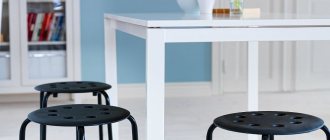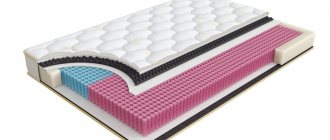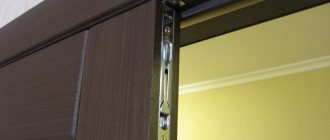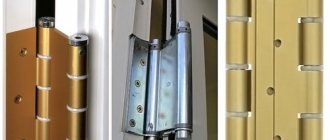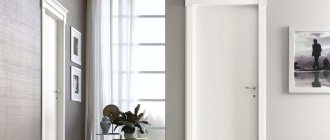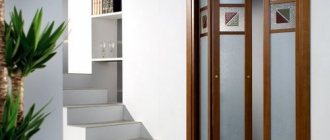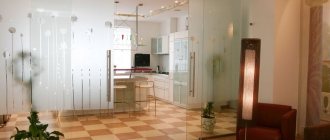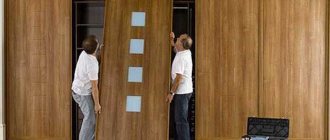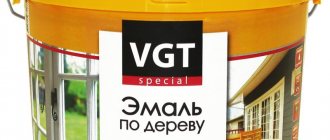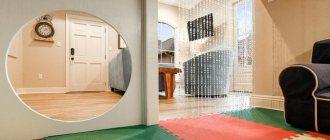Advantages of eco-veneer models
Consumers consider the main advantage of interior structures of this type to be their attractive appearance. Eco-veneer imitates wood better than any other modern material. Also, apartment owners include the following advantages of such doors:
- environmental cleanliness;
- high resistance to abrasion, and, consequently, long service life;
- the ability of the canvas to withstand sudden temperature fluctuations without harm;
- resistance to scratches and chips;
- UV resistance;
- ease of care.
There are very good reviews from consumers on the Internet about the use of interior doors made of eco-veneer. Many apartment owners, of course, would like to know what eco-veneer is. It is a CPL multilayer material made from wood fiber using polymer binders.
Consumers consider their light weight to be the only drawback of eco-veneer doors. This does not have a very good effect on the performance characteristics of such structures. Also, judging by the reviews, consumers consider the minor drawbacks of interior eco-veneer doors to be not very good characteristics in terms of sound insulation.
Eco-veneer interior doors: pros and cons
Over time, objects made from natural materials disappear from interiors, and they are replaced by artificial analogues. Even wood, which is better suited for making furniture and doors, is included in the list of objects of unaffordable luxury. This state of affairs is pushing many manufacturers to create new materials that can fully compete with natural ones and at the same time be available to a wide range of buyers. Eco-veneer is one of the popular options that allows companies to save on raw materials without compromising the quality of the finished product.
Eco-veneer production: features
This material is made from natural wood fibers, which are obtained from wood processing waste. Using special equipment, they are well prepared, painted, thoroughly mixed and glued. In its finished form, eco-veneer is a sheet material that is rolled into rolls and supplied in this form to various enterprises. Thanks to its multi-layer nature, it resists wear and tear, and the use of natural fibers gives it a stunning wood-like appearance. We can safely say that eco-veneer conveys all the beauty and warmth of wood better than other types of cladding.
Eco-veneer doors: main advantages
Doors made using this material are becoming more and more popular every year. And this is due to the large number of advantages that they have. Among them:
- Impact resistance. Eco-veneer is quite difficult to split or scratch, so doors covered with it look flawless for many years.
- Resistant to temperature changes. With high humidity, such doors do not swell and do not crack during heat, which significantly increases their service life. Thus, they can be installed in bathrooms and other rooms with an unfavorable microclimate.
- Relatively light weight compared to conventional veneer, which is a thin cut from solid wood.
- Rich color palette. Before gluing, the fibers are painted with special compounds, so the colors of eco-veneer clearly outperform the palette of natural shades. Thanks to this, you can easily match the doors to a particular interior, no matter how unusual it may seem. For example, snow-white wood does not exist in nature, but with eco-veneer this problem is solved.
- High density. The lack of a porous surface makes eco-veneer doors an unfavorable environment for the growth of bacteria. Therefore, even in a humid environment, over time, such canvases do not become covered with mold or mildew.
- UV resistance. Natural wood without special protection quickly fades in the sun and takes on an unsightly appearance, but eco-veneer is not afraid of the sun's rays.
- Wide variety of options. Eco-veneer is quite easy to further process in the production of doors. Therefore, in every specialized store you can find a huge assortment of door panels created using this material.
- Wide range of applications. Such doors look equally good in a house, apartment and office, so buying them is a win-win option.
- Safety. Eco-veneer does not contain hazardous substances such as phenol, chloride, formaldehyde and others. Therefore, doors can be installed in both residential and non-residential premises without worrying about the health of household members and pets.
- Low cost. Compared to many doors, options made using eco-veneer stand out both in terms of characteristics and attractive price. Many people choose them for this reason.
Eco-veneer doors: main disadvantages
Despite the large number of advantages, doors lined with eco-veneer also have significant disadvantages that you should be aware of. For example, if their coating is seriously damaged, then restoring it is practically useless. In addition, such doors cannot boast of good sound insulation, since sounds pass through them with slight muffling. That is why such canvases are not recommended for installation in rooms that need to be protected from excessive noise. It is also worth considering that eco-veneer fibers are interconnected by a polymer composition that prevents normal air exchange. Consequently, you will have to ventilate the premises more often if such doors are installed in your apartment or office.
How to choose the right eco-veneer doors
Many people know about this facing material, but when choosing doors, not everyone can accurately determine what exactly it decorates the door leaf they like. How to distinguish eco-veneer from other coatings and what should you pay attention to when choosing such doors? To avoid getting into trouble, experts advise:
- Carefully inspect the door leaf and touch it. Eco-veneer differs markedly from natural veneer, solid wood and PVC. It cannot be scratched if you lightly scratch it with a fingernail, its texture is more textured to the touch than that of natural wood, and it does not peel off like film.
- Pay attention to the cost. Door leaves lined with eco-veneer are inexpensive, which is what primarily attracts buyers. However, if a product has a very low price, then it should also be avoided, since it can be made from completely different materials.
- Don’t be afraid to ask consultants about the product. A professional specialist will be able to quickly find a door leaf that meets the client’s specific needs and explain why the doors presented have a particular price.
- Study customer reviews. When going to the store to buy a door, you need to read truthful customer reviews about the seller on the Internet. This way you can avoid unnecessary waste of time and money and protect yourself from disappointment.
Doors made of eco-veneer have both pros and cons, but nevertheless they are quite worthy of taking a place in modern interiors.
The best manufacturers
Most modern companies supply eco-veneer doors of fairly good quality to the domestic market. However, consumers still consider models of some brands to be the most beautiful, durable and easy to use. The rating of companies selling eco-veneer doors on the Russian market currently looks something like this:
- BELWOODDOORS.
- LLC "YurkasDors"
- "Cabinetmaker".
- "Enjoyment."
- "Odintsovo".
- "Bravo".
- "Volkhovets"
- Chebokarsk Door Factory LLC.
BELWOODDOORS brand models: consumer reviews
Belorusskaya has been supplying interior doors to the Russian market since 1999. Consumers attribute, first of all, an attractive appearance to the advantages of products from this manufacturer. Models made from BelWoodDoors eco-veneer, according to apartment owners, imitate natural wood very realistically. In particular, the interior designs of this brand “Perfecta DG enamel vanilla” and “Domino” are very popular among consumers. Both of these models are manufactured by BELWOODDOORS from imported eco-veneer with a 3D effect. It is this material, mainly German and Japanese, that this manufacturer most often uses in the production of its doors.
Interior structures from BelWoodDoors made of eco-veneer can be either blank or decorated with spectacular inserts made of decorative glass. If desired, consumers have the opportunity to select models from this company, intended for installation not only in residential premises, but also in offices, as well as in various types of administrative and public buildings.
Property owners consider the main advantages of the doors of this Belarusian brand to be the ideal combination of price/quality. Such interior structures are cheaper than models from many others, including Russian or Belarusian manufacturers. However, they can often last much longer.
Doors with eco-veneer finishing
Since special attention is always paid to safety, the prefix “eco” to the name is perceived by the consumer as an important component of it - the environmental friendliness of the material, for example, “eco-leather”. Some manufacturers take advantage of this, trying to attract attention to their next new development. And a dual situation is created - on the one hand, their products do not pose a threat to the user’s health, but on the other, they are produced from not entirely harmless components. Let us consider the relevance of the prefix “eco” in relation to veneer coverings, including eco-veneer.
Veneering is a cladding method that involves sticking so-called veneer – a thin sheet of wood – onto the base. Veneered products look like they are made of wood.
Advantages of veneer finishing:
- The product is coated with a beautiful pattern, which can be enhanced with additional processing;
- A base made of inexpensive material can be cheaply and effectively decorated to look like exotic wood;
- Minor damage to the cladding can be repaired by spot repairs on your own;
- Refreshing restoration of the coating is carried out without significant costs;
- Cladding operations can be performed independently and without professional tools.
All produced veneer is divided into 2 groups:
- Natural.
- Reconstructed - from wood chips processed in various ways.
Natural veneer is made from solid wood and can be peeled, planed or sawn. Depending on the manufacturing method, its thickness varies from 0.1 to 10 mm and, taking into account the type of wood, determines the scope of application: finishing furniture, carpentry and car interiors, making musical instruments, producing plywood. A nuance in the classification of solid wood material: such veneer is considered natural only in the absence of subsequent decorative processing to imitate more valuable types of wood (dying, embossing, perforating).
All three methods of cutting solid wood and the accompanying processing preserve natural veneer with the characteristics of the original raw material - natural wood, including environmental friendliness, so adding the prefix “eco” to its name is unnecessary.
The group of reconstructed veneers consists of fine-line veneers (“clean line”) and multi-veneers. Both varieties are made from natural chips of low-value wood, but differ in manufacturing technology and visually.
Fine-line veneer is produced as follows:
- The wood is passed through a peeling machine, after which the resulting veneer sheets are dried, cut into the required format and grouped by color;
- Formatted veneer is immersed in dye until through-colored;
- Stacks with layers of glue are formed from painted sheets of different tones;
- The stacks are pressed, dried and polished, after which a veneer covering of the required thickness is produced from these artificially obtained masses using the planing method.
The percentage of fine-line veneer components is as follows:
- wood - 92-94%;
- glue - 7-8%;
- dye – up to 2%.
fine-line is produced in thicknesses from 0.3 to 5 mm and can have a color that is not characteristic of natural wood. “Fine-line” is several times cheaper than natural veneer, but is in no way inferior to it, and perhaps superior in aesthetics, since it does not contain natural wood defects – knots and microcracks.
The texture of the fine-line surface resembles plastic, but the composition of the material indicates the environmental friendliness of this cladding, the name of which also does not need the prefix “eco”.
The method of producing multi-veneer is similar to the production of “fine-line”, but the final product looks different - more decorative, outwardly bearing little resemblance to natural veneer. The starting raw material for the production of multi-veneer is also chips of low-value wood species, but the process of its reconstruction is more complicated. The final product is a smooth or textured coating with multi-colored patterns.
The lack of external resemblance of such material to natural veneer is compensated by the effectiveness of its color schemes and variety of designs. Multi-veneer is environmentally friendly because, like fine-line, it is made from natural wood, so the prefix “eco” is not used in the name of this coating.
What is eco-veneer, and how good are doors finished with it?
If you carefully study the offers from various manufacturers, you will find out that eco-veneer is a collective term that is applied to all non-natural coatings of door panels (laminated coatings are a separate group, an exception).
A significant proportion of these coatings are made up of various films based on polypropylene or PVC. At the same time, polypropylene is much more environmentally friendly than PVC, but all films receive the laudatory prefix “eco-”. In addition, such artificial surfaces can vary significantly in characteristics. For example, the manufacturer Belwooddoors (Belarus) uses textured paper, which it also calls eco-veneer, for lining its doors. The market also offers other models of door leaves, the coatings of which, with the intriguing names 3D-Flex or 3D Graf, are called eco-veneer, but they are also polymer films of various thicknesses and textures.
Statements that eco-veneer is made from dyed and glued wood fibers are a marketing technique. This technology is complex and would result in a much higher price for the doors. In addition, the cladding made using this technology would be fragile, but eco-veneer is flexible, which makes it possible to wrap products with it without joints.
Having dealt with the prefix “eco-” in the name, what is the answer to the question: “Is it worth buying doors finished with so-called eco-veneer?”, we answer: “Yes, such door leaves have many advantages”:
- Wear resistance – resistant to abrasion;
- The finishing has no joints on the edges, which means that moisture will not get under the edge that has peeled off over time;
- Resistant to moisture and household chemicals - can be installed in the bathroom, suitable for cleaning;
- Large selection of colors and textures - from natural to decorative;
- The price is several times lower than doors with natural veneer;
- Non-toxic (except during combustion).
“Disadvantages” of eco-veneer door cladding:
- complexity of spot repairs;
- inferior in impact resistance to natural and reconstructed veneers.
YurkasDors products: opinion of apartment owners
This company, like many others specializing in the production of interior doors, appeared on the domestic market relatively recently. The head office of this company is located in Moscow. Judging by the reviews, Yurkas eco-veneer interior doors are of simply excellent quality. Unlike designs from many other manufacturers, models of this brand are quite heavy and therefore very easy to use.
With good quality, YurkasDors doors, according to consumers, are also distinguished by a rather pleasant design. Of course, apartment owners consider their rather low cost to be an advantage of this brand of construction.
Laminated door products
Interior doors coated with laminate film have become widespread in recent years. They are significantly cheaper in cost than veneered door products of the same quality class. They can be classified as a budget option, accessible to people of low income.
Laminate, which is obtained from cellulose fibers impregnated with synthetic resins, can be painted in any color range with the application, if necessary, of designs, patterns, and various compositions. This material gives the product special strength and resistance to almost any type of external influence. Laminate doors are made from high-density fiberboard, which is created by hot vacuum pressing during production. Such products have excellent environmental safety indicators for humans.
Laminated doors have other advantages. These include good tolerance to temperature changes and excellent resistance to almost any detergent used in the care of such products. In addition, caring for them does not cause any difficulties and does not require too much time or money. But the main advantage, of course, is the relative cheapness of this product.
Attention! Too cheap products can be covered with a laminate of very low quality, as a result of which the surface of the canvas will begin to quickly crumble, especially in the edge area, and the door will soon acquire an unpresentable appearance.
Despite all these advantages, laminated doors also have their disadvantages:
- smooth texture of the surface of the material, which many may not like;
- some external similarity of door products, which is sometimes annoying;
- impossibility of restoration in case of mechanical damage.
What do consumers think about the products?
This Russian company was created in 1993. Its head office is located in Chelyabinsk. Currently, there are official representative offices of this manufacturer in 60 regions of the Russian Federation. So it won’t be difficult for residents of our country to purchase eco-veneer doors from “Krasnoderevshchik” if they so desire.
Models from CPL are presented by this company in its most extensive line 5000. There are good reviews on the Internet about interior doors made from eco-veneer “Cabinetwood”, among other things, because, if necessary, you can choose them for absolutely any interior. The company produces such designs, for example, in the colors “Bleached Oak”, “Biscotto Walnut”, “Black Oak”, etc. Like “BelWoodDoors”, it uses imported (Japanese) eco-veneer with a 3D effect to make its doors. At the enterprises of this manufacturer, the canvases of interior structures are additionally coated with a unique patented varnish.
Models "Zador"
This manufacturer has been supplying eco-veneer doors to the market since 2011. Consumers are familiar with them under the “Sofya” brand. Interior designs from the Zador factory belong to the middle price category. They usually cost less than models from Cabinetmaker and about the same as designs from BELWOODDOORS. The door frame from this manufacturer is made of solid pine. This company can use eco-veneer in the production of interior structures both regular and with a 3D effect.
In addition to a rather attractive appearance, consumers include high build quality among the advantages of Sophia doors. Judging by the reviews of interior doors made from eco-veneer of this brand available on the Internet, such designs can easily withstand even the most careless handling. Models of this brand do not dry out, withstand household chemicals well and do not fade in the sun.
Particularly popular among consumers are the Vancouver series eco-veneer interior doors produced by this company. The models in this line have received good reviews primarily for their stylish appearance. At the same time, the most beautiful Vancouver model, according to apartment owners, is the American Walnut.
Eco-veneer for finishing
To find out which doors are better - PVC or eco-veneer, you need to understand what their difference is. Eco-veneer is a unique combination of wood material with organic filler. It is made from crushed wood fibers with the addition of organic resins, and then applied to products by pressing. Judging by expert reviews, this technology provides a number of advantages.
PVC doors or eco-veneer: which is better?
The first option is resistant to mechanical damage: scratches, chips, and peeling are practically guaranteed here. The coating is much more durable and exhibits excellent wear resistance.
- The material does not fade under the sun at all, since the technology used simply does not allow this.
- The coating imitates natural wood with much greater convincing. Moreover, imitation includes not only color and structure, but also sensation.
- Compared to a product lined with natural veneer, a sash finished with eco-veneer costs much less. However, laminated with polyvinyl chloride is even less expensive.
- Lamination allows you to repair an interior door - covering it with film or veneer. Eco-veneer coating cannot be restored. This is the most serious drawback, according to reviews.
Which interior doors to choose - PVC and eco-veneer - depends on the significance of the listed factors. The photo shows samples of sashes.
There are many different door coverings. This is natural wood veneer, lamination, staining, tinting. But PVC and eco-veneer have become the most popular recently. High quality products and low prices significantly increase the demand for designs. The question arises: eco-veneer or PVC, which is better? Let's try to figure it out.
Eco-veneer has been used in Europe for a long time. In the CIS countries, laminated doors appeared relatively recently. But not everyone knows what eco-veneer is.
The door covering is based on polypropylene film. Natural wood fibers of the desired color and a synthetic binder are applied to it. Using a special press, the mixture on the film is compressed to the required thickness.
Attention! The coating is environmentally friendly, does not cause allergies and does not harm the environment.
During the pressing process, tiny air bubbles are removed. The finished coating reliably protects the door frame from the influence of the external environment. The frame is made of MDF or wood.
Doors "Odintsovo": customer reviews
This Russian company supplies the market with products under the Verda brand. The history of the company, whose main office is located in the west of Moscow, began back in the 30s of the last century. Currently, the official representative of this manufacturer on the domestic market is. This company has been producing doors for more than 10 years.
Like the BelWoodDors and Sofya models, the Verda designs belong to the middle price category. Doors of this brand are manufactured using modern Italian and German equipment. Judging by the reviews of interior doors made of eco-veneer from Verda customers, their quality is simply excellent.
Bravo models: reviews
The head office of this manufacturer is located in Moscow. There are also quite good reviews of interior doors made from eco-veneer “Bravo” on the Internet. The advantages of models of this brand are, first of all, attractive original design. Apartment owners also praise these doors for their good quality. Even the platbands of the Bravo models, judging by consumer reviews, unlike the interior structures of many other modern manufacturers, are distinguished by their considerable thickness and, consequently, high strength. In any case, property owners never have problems installing Bravo doors.
Consumer opinion about Volkhovets models
The company supplying the market with doors of this brand was founded in Russia in 1995. Currently, it has 2 production sites - one in Maykop and one in Veliky Novgorod. For the production of interior doors, the company uses high-quality Italian eco-veneer.
Currently, the company supplies the market with interior structures of a wide variety of designs. If desired, consumers have the opportunity to purchase a model of this brand from “Snow-White Linden” to dark “Oak”. That is, you can choose such an interior design for any interior.
The advantages of doors from this manufacturer are, first of all, a very attractive design. In the interior, doors from Volkhovets look more attractive than designs from many other companies. Some of the disadvantages of models of this brand include a fairly thin outer coating. Aggressive household chemicals (hair dye, peroxide, etc.) can, unfortunately, corrode it. Apartment owners who decide to purchase doors from this manufacturer should keep this in mind.
What is eco-veneer: characteristics of doors
The doors have a hollow wooden frame, onto the surface of which a thin layer of eco-veneer is applied. It has the second name CPL, which translates as subject to long-term pressing. During manufacturing, a mixture of wood fibers with a synthetic binder material is pressed. As a result, the structure of the material has a volumetric effect that misleads the consumer. It is often confused with veneer.
The material is produced from waste from the wood processing industry, which is broken down using special equipment. Small fibers are dyed, mixed and glued together. This technique of coloring wood fibers eliminates differences in the color of the finished product, gives any shade, and imitates wood. Often produced in the following forms: wenge, ice cream, bleached oak and others. Each pattern is unique.
Different shades of doorways
The material is pressed gradually with increasing force. This makes it possible to squeeze out small air bubbles from the mixture. As a result, ekopchon sheet material is formed, which is supplied in rolls to factories for the production of interior doors, where it is applied to the products.
Cheboksary Door Factory LLC
There are also very good reviews from consumers about the products of this young enterprise on the Internet. Eco-veneer interior doors from Cheboksary are made, as the owners of houses and apartments note, from very high quality materials. They can be installed safely both in ordinary rooms and in damp ones.
Also, the advantages of products from this manufacturer include a fairly large selection of models. According to apartment owners, doors of this brand are already capable of seriously competing with the designs of companies that have existed on the domestic market much longer.
